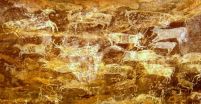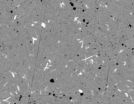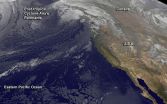(Press-News.org) For magnetic fusion energy to fuel future power plants, scientists must find ways to control the interactions that take place between the volatile edge of the plasma and the walls that surround it in fusion facilities. Such interactions can profoundly affect conditions at the superhot core of the plasma in ways that include kicking up impurities that cool down the core and halt fusion reactions.
Researchers have improved plasma performance by applying lithium coatings to the walls of fusion facilities. But a complete understanding of the mechanism behind this improvement remains elusive. Among the puzzles is how temperature affects the ability of lithium to absorb and retain the deuterium particles that stray from the fuel that creates fusion reactions.
Answers are now emerging from a new surface-science laboratory at the Princeton Plasma Physics Laboratory that can probe lithium coatings that are just three atoms thick. Such probes have examined the surface composition of lithium films on a molybdenum substrate after the films were exposed to deuterium ions. Researchers controlled the surface temperatures, impurity levels and other conditions independently of one another, which could not be done in the complex environment of fusion devices like tokamaks.
The experiments showed that the ability of ultrathin lithium films to retain deuterium drops as the temperature of the molybdenum substrate rises — a result that provides insight into how lithium affects the performance of tokamaks. Experiments further showed that exposing the lithium to oxygen improved deuterium retention at temperatures below about 400 degrees Kelvin. But without exposure to oxygen, the researchers found, lithium films could retain deuterium at higher temperatures as a result of lithium-deuterium bonding.
Armed with these findings, scientists will be better able to determine how to use lithium to enhance the performance of fusion plasmas.
INFORMATION:
Contact:
Angela Capece, acapece@pppl.gov
Abstract:
YI2.00005: The Effects of Temperature and Oxidation on Deuterium Retention in Solid and Liquid Lithium Films on Molybdenum Plasma-Facing Components
11:30 AM–12:00 PM, Friday, October 31, 2014
Bissonet
Session YI2: Technology of Plasma Facing Surfaces, Landau-Spitzer Award and Post Deadline Talk
9:30 AM–12:30 PM, Friday, October 31, 2014
Bissonet
Postcards from the plasma edge
News from the 2014 APS Division of Plasma Physics Meeting
2014-10-28
ELSE PRESS RELEASES FROM THIS DATE:
Insights into the physics of space weather that disrupts cell phones and creates Earthly havoc
2014-10-28
Each second, the sun hurls millions of tons of hot, charged plasma gas into space. This
volatile "solar wind" buffets the magnetosphere, the magnetic field that surrounds the Earth, and can whip up geomagnetic storms that disrupt cell phone service, damage satellites and blackout power grids. Precise predictions of such outbursts could prompt measures to cope with them, just as forecasts here on Earth warn of approaching hurricanes and thunderstorms.
Researchers throughout the United States are using laboratory experiments to uncover important physics behind this space ...
Governments should take active lead to create healthy food environments to prevent CVD
2014-10-28
Philadelphia, PA, October 28, 2014 – Canadian health organizations are calling upon governments to take a leadership role in creating healthy food environments. They say that implementing strategies that facilitate access to affordable healthy foods and beverages in places where Canadians work, live, and play could play a key role in preventing diet-related disease and health risk such as obesity and hypertension, and ultimately improve cardiovascular health, This call for action is published in the Canadian Journal of Cardiology.
In 2010, unhealthy eating was identified ...
Ancient auditory illusions reflected in prehistoric art?
2014-10-28
WASHINGTON, D.C., October 28, 2014 – Some of mankind's earliest and most mysterious artistic achievements—including prehistoric cave paintings, canyon petroglyphs and megalithic structures such as Stonehenge—may have been inspired by the behaviors of sound waves being misinterpreted as "supernatural."
During the 168th Meeting of the Acoustical Society of America (ASA), to be held October 27-31, 2014 at the Indianapolis Marriott Downtown Hotel, Steven J. Waller, of Rock Art Acoustics, will describe several ways virtual sound images and absorbers can ...
'Reverse engineering' materials for more efficient heating and cooling
2014-10-28
WASHINGTON, D.C., October 28, 2014 – If you've ever gone for a spin in a luxury car and felt your back being warmed or cooled by a seat-based climate control system, then you've likely experienced the benefits of a class of materials called thermoelectrics. Thermoelectric materials convert heat into electricity, and vice versa, and they have many advantages over more traditional heating and cooling systems.
Recently, researchers have observed that the performance of some thermoelectric materials can be improved by combining different solid phases -- more than one ...
Calming the plasma edge: The tail that wags the dog
2014-10-28
Experiments on the DIII-D tokamak that General Atomics operates for the U.S. Department of Energy (DOE) have demonstrated the ability of lithium injections to transiently double the temperature and pressure at the edge of the plasma and delay the onset of instabilities and other transients. Researchers conducted the experiments using a lithium- injection device developed at the DOE's Princeton Plasma Physics Laboratory (PPPL).
Lithium can play an important role in controlling the edge region and hence the evolution of the entire plasma. For example, researchers have ...
Remnants of tropical depression soaking Central America
2014-10-28
NASA's Terra satellite passed over Tropical Storm Hanna on Oct. 27 when it made landfall near the northern Nicaragua and southern Honduras border.
On Oct. 27 at 16:00 UTC (12 p.m. EDT) the MODIS instrument aboard NASA's Terra satellite captured a visible image of Tropical Storm Hanna straddling the border between Honduras and Nicaragua. The image, created by NASA's MODIS Rapid Response Team at NASA's Goddard Space Flight Center in Greenbelt, Maryland, showed strong thunderstorms on both sides of the border, bringing heavy rainfall to those area.
At 10 a.m. EDT on Oct. ...
New study uses DNA sequences to look back in time at key events in plant evolution
2014-10-28
Scientists from North America, Europe and China have published a paper in the Proceedings of the National Academy of Sciences that reveals important details about key transitions in the evolution of plant life on our planet.
From strange and exotic algae, mosses, ferns, trees and flowers growing deep in steamy rainforests to the grains and vegetables we eat and the ornamental plants adorning our homes, all plant life on Earth shares over a billion years of history.
"Our study generated DNA sequences from a vast number of distantly related plants, and we developed new ...
Ana's remnants raining and gusting in British Columbia, Canada
2014-10-28
NOAA's GOES-West satellite captured an image of post-tropical cyclone Ana's remnant clouds raining on British Columbia, Canada today, Oct. 28. Wind warnings along some coastal sections of British Columbia continued today as the storm moved through the region.
NOAA's GOES-West satellite gathered infrared data on Ana's remnant clouds and that data was made into an image by NASA/NOAA's GOES Project at NASA's Goddard Space Flight Center in Greenbelt, Maryland. In the image the remnant clouds resemble a frontal system.
Environment Canada's Meteorological Service continued ...
Breathe easier: Get your D
2014-10-28
Asthma, which inflames and narrows the airways, has become more common in recent years. While there is no known cure, asthma can be managed with medication and by avoiding allergens and other triggers. A new study by a Tel Aviv University researcher points to a convenient, free way to manage acute asthmatic episodes — catching some rays outside.
According to a paper recently published in the journal Allergy, measuring and, if need be, boosting Vitamin D levels could help manage asthma attacks. The research, conducted by Dr. Ronit Confino-Cohen of TAU's Sackler Faculty ...
Using radio waves to control the density in a fusion plasma
2014-10-28
Recent fusion experiments on the DIII-D tokamak at General Atomics (San Diego) and the Alcator C-Mod tokamak at MIT (Cambridge, Massachusetts), show that beaming microwaves into the center of the plasma can be used to control the density in the center of the plasma, where a fusion reactor would produce most of its power. Several megawatts of microwaves mimic the way fusion reactions would supply heat to plasma electrons to keep the "fusion burn" going.
The new experiments reveal that turbulent density fluctuations in the inner core intensify when most of the heat goes ...
LAST 30 PRESS RELEASES:
Norbert Holtkamp appointed director of Fermi National Accelerator Laboratory
New agentic AI platform accelerates advanced optics design
Biologists discover neurons use physical signals — not electricity — to stabilize communication
Researchers discover that a hormone can access the brain by hitchhiking
University of Oklahoma researcher awarded funding to pursue AI-powered material design
Exploring how the visual system recovers following injury
Support for parents with infants at pediatric check-ups leads to better reading and math skills in elementary school
Kids’ behavioral health is a growing share of family health costs
Day & night: Cancer disrupts the brain’s natural rhythm
COVID-19 vaccination significantly reduces risk to pregnant women and baby
The role of vaccination in maternal and perinatal outcomes associated with COVID-19 in pregnancy
Mayo Clinic smartwatch system helps parents shorten and defuse children's severe tantrums early
Behavioral health spending spikes to 40% of all children’s health expenditures, nearly doubling in a decade
Digital cognitive behavioral treatment for generalized anxiety disorder
Expenditures for pediatric behavioral health care over time and estimated family financial burden
Air conditioning in nursing homes and mortality during extreme heat
The Alps to lose a record number of glaciers in the next decade
What makes a good proton conductor?
New science reporting guide published for journalists in Bulgaria
New international study reveals major survival gaps among children with cancer
New science reporting guide published for journalists in Turkey
Scientists develop a smarter mRNA therapy that knows which cells to target
Neuroanatomy-informed brain–machine hybrid intelligence for robust acoustic target detection
Eight SwRI hydrogen projects funded by ENERGYWERX
The Lundquist Institute and its start-up company Vitalex Biosciences Announces Strategic Advancement of Second-Generation fungal Vaccine VXV-01 through Phase 1 Trials under $40 Million Competitive Con
Fine particles in pollution are associated with early signs of autoimmune disease
Review article | Towards a Global Ground-Based Earth Observatory (GGBEO): Leveraging existing systems and networks
Penn and UMich create world’s smallest programmable, autonomous robots
Cleveland researchers launch first major study to address ‘hidden performance killer’ in athletes
To connect across politics, try saying what you oppose
[Press-News.org] Postcards from the plasma edgeNews from the 2014 APS Division of Plasma Physics Meeting







